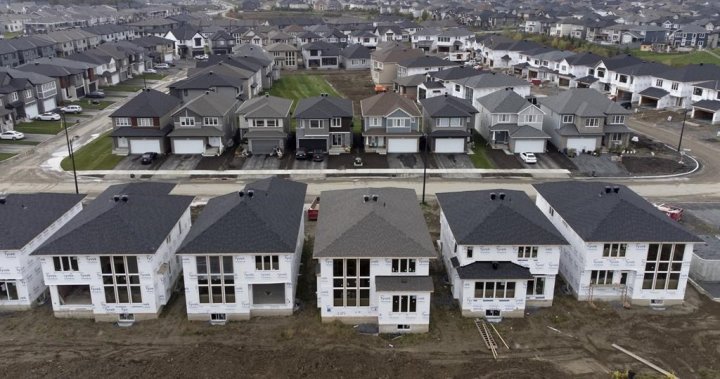Canada will need to build roughly 1.3 million more new homes than are currently projected to eliminate the gap between housing supply and demand, according to a new report by the Parliamentary Budget Officer (PBO).
The figure translates into about 181,000 additional units completed on average each year until 2030, to result in a total of 3.1 million net housing units.
The report by parliamentary budget officer Yves Giroux, released Thursday, evaluates the imbalance in the housing market by comparing the total home vacancy rate in Canada to its long-term historical average.
It defines the housing gap as “the projected number of additional housing units required to balance housing demand and supply based on the total vacancy rate” by 2030.
Canada has been averaging 188,000 new housing units annually since 2015, the report notes. Looking forward, the budget watchdog expects that will grow to about 255,000 annually to a total of 1.8 million housing completions in Canada by 2030.
But it’s not enough.
The report says closing the housing gap would require a total of 3.1 million units to be completed by 2030, or an average of 426,000 units a year.
“This pace of housing completion would represent an increase of 80 per cent above the record level of net completions in 2023, sustained for 7 years,” the report explains.
The report defines a household as “a person or a group of persons (other than foreign residents) who occupy a private dwelling and do not have a usual place of residence elsewhere in Canada.”
The number of household formations surged past pre-pandemic levels last year, the report suggested, to an average of 460,000.

The report predicts that household formation will continue to outpace home completions from now until 2030, meaning that there are more families in need of homes than there are units available. On average, there are 255,000 units available for 272,000 households annually.
The total vacancy rate in Canada also reached a record low of 5.1 per cent in 2023, according to the PBO. It notes that the imbalance between households and completed homes would push the total home vacancy rate down to 3.9 per cent in 2025, before stabilizing at around 4 per cent in 2030.
Financial news and insights
delivered to your email every Saturday.
The findings come after weeks of announcements of federal spending promising billions toward tackling the country’s housing crisis.
Last week, Prime Minister Justin Trudeau unveiled a $600 million plan to boost pre-fabricated housing after announcing a $6-billion housing infrastructure fund earlier this month. The latter would allow four unit dwellings by default in municipal zoning rules. The funding also includes a push for “missing middle homes” such as duplexes, triplexes, townhouses and other types of multi-unit homes.
Late last year, Fraser announced plans to revive an old wartime housing program with the creation of a catalogue of prefabricated, factory-built home designs.
The goal is to standardize designs that can get through municipal project approvals more quickly, and make it easier for developers to build them in larger numbers.
“We’re not just going to put this money on the table, wash our hands of the issue and walk away. We’re going to insist that our partners make certain kinds of changes that make it easier and faster to build homes in this country,” Housing Minister Sean Fraser said regarding the recently announced billion-dollar fund.
The PBO report references Statistics Canada’s demographic estimates from September 2023, which found that the country’s population had grown by 1.2 million people that year — the highest growth rate since 1957.

The PBO also references the Bank of Canada’s (BOC) Monetary Policy Report from January, that said “a larger increase in newcomers than in the past is adding pressure to the structural supply constraint in housing.”
The BOC’s message reflects the PBO’s findings, the recent report says.
“Indeed, the Bank assessed that the larger influx of newcomers has helped push the total vacancy rate—the number of vacant units, for sale or rent, relative to the total stock of housing units—to record lows,” it says.
Fraser said at a keynote address in Ottawa Wednesday that he fears Canada will soon “hit a ceiling” on the number of homes that can be built.
“This isn’t the fault of the industry… but we need to help them grow at a faster pace,” Fraser said, referring to the federal government’s role in addressing the housing crisis.
— with files from Global News’ David Baxter
© 2024 Global News, a division of Corus Entertainment Inc.



